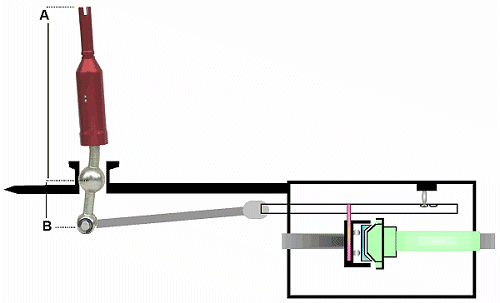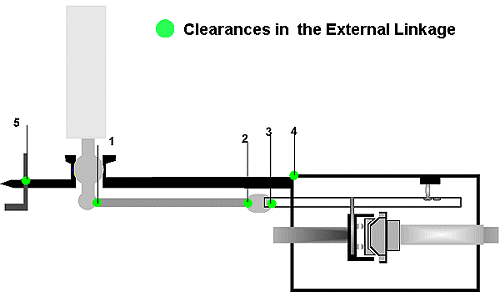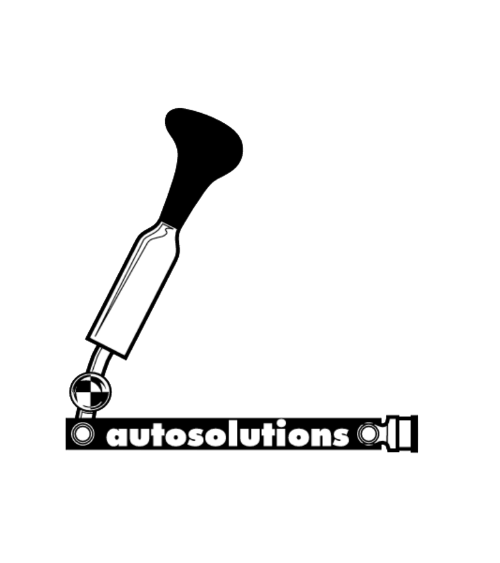This is a Simplification of the BMW Mechanism

How The Thing Shifts
This is a thighbone connected to the shin bone type of a thing. On a BMW the shifter lever is not plugged inside the transmission. Instead the level sits behind the transmission nestled in a bracket that is connected to that gearbox and the lever remotely activates the innards of the transmission by rotating and moving the selector rod and the coupler front to back to engage the desired gear
The rod coupler assembly moves and rotates the shift rail which in turns moves auxilliary shift rails and eventually the synchro assembly for the desired gear.
Shift in 4th gear will ya
Move the Shift lever back. The upper portion of the lever A pivots around the pivot ball and like a see saw on a playground the bottom portion of the lever moves forward pushing the selector rod forward which in turn pivots at the coupler and that coupler pushes the shift rail inside the transmission. Because you did not move the lever left or right prior to moving it backwards, the shift rail does not rotate and simply moves forward by the distance "a"

Take a peak at the above Diagram while you downshift from 4th to 3rd. The shift effort at the knob is redirected by the lever and multiplied by the ratio A/B. This ratio is the mechanical advantage of the shift lever and multiplies the force at the knob by a factor as high as 8 on some cars and as low as 4 on other . A 6 to 1 factor for instance, is quite advantageous. It multiplies the force at the knob by 6 so that a 15 Lbs. force at the knob can become a 90-lbs force at the bottom of the lever. A 4 to 1 factor is less advantageous and only multiplies the force at the knob by 4. Why does the A/B ratio vary from car model to car model. Two reasons we think. First is the intended purpose of the car. A 5 series is typically a daily driver with a requirement of an easy comfortable shift whereas an e30M3 is a racer with little to no aspiration of being a grocery getter. As such the A/B ratio on an 85 535i will be considerably greater than that of an 88 M3 even though both cars use the same transmission. Second is the design of the transmission. The 88 M3 transmission was originally designed sometimes in the sixties whereas the e92 M3 transmission was designed about half a century later. Both cars are sport cars but the newer transmission is more efficient at transmitting the force applied to its shift rail than its older sister and therefore can make use of a lower A/B ratio. As an aside the greater the mechanical advantage the more travel at the shift knob. And the reverse is true. Reduce the mechanical advantage and shorten the throw. Short Shift kit anyone?
Moving on … and back to our 6 to 1 ratio which generates 90Lbs of force at the selector rod when 15Lbs is applied at the knob. The selector rod transmits this 90 Lbs. force almost completely to the shift rail that operates the transmission. To be precise, this force is reduced slightly since the selector rod is not always in line with the shift rail*.
Past the shift rail the shifting force continues to propagate and has to overcome the resistance of the shift rail detents (a) and the resistance of the synchronizer sleeve detents (b) and various frictional resistances between the moving parts of the gearbox and its casing. Finally, most of the force is spent fighting any selected gear’s reluctance to align itself with the synchronizer sleeve (c)**.
*The resultant force on the rail is actually 90Lbs multiplied by the Cosine of the angle of the rod to the rail. The greater the angle the smaller the resultant horizontal force at the transmission rail. A 60-degree angle has a cosine of .5 and will effectively reduce the force by half.
In practicality however the angle of the selector rod is around 4 degrees and rarely exceeds 10 degrees. The cosines of these angles are respectively .997 and .984 so the resultant force travels almost intact to the rail.
** Of course this is a simplified explanation. between the rail and the synchro are auxilliary rails each of which operates a pair of gear. For example the main rail rotated CCW will actuate the auxilliary 5th and 6th gear rail, pushed forward without rotation will allow the driver to chose 3rd or 4th. Another rail controls 1st and 2nd and yet another reverse
That Shifting Effort?
A Little of it is Spent Moving Springs and Detents...

A Little Friction Goes a Long Way
Red Dots show the various springs and detents (typically balls or plungers moving in a hole bored into the aluminium transmission case) and the spots where friction occurs during a shift. A transmission that has been running low on oil will require undue effort. What's worse is that the damage may be permanent because the springs will jam in their holes and the friction surfaces being typically softer than the detents will gall . Once this happens, the damage is done and adding fluid at that point will not unjam the springs or re polish the friction surfaces. Keep an eye on your fluid level.
TRIVIA OR USEFUL KNOWLEDGE : No doubt you have noticed how shifting in the same gear over and over when the engine is off and the car stopped is easier the 2nd time or third time around? The why is because the first time you shifted you overcame some of the static resistance of the transmission by aligning the synchro of that particular gear. Once that alignment is effectuated there is no need to realign the gears again until the car moves . So the second shift only requires enough effort to move the detents and is theefore easier than the first.Need more details? Read on:
The shifting force is applied against the shift rail and pushes it forward. The shift rail rubs against the case and some of this force is lost in heat. Another portion of the force activates various detents. Here, spring loaded detent balls climb on a ramp cut into the shift rail and overcome the resistance of small springs (1) Similarly the shift rail activates shift forks that in turn move the synchronizer sleeve compressing other detent springs (2) in the sleeve body and allowing clips in the body to retract.
However most of the force is used by the synchronizer-sleeve teeth meshing with their counterparts on the selected synchro-meshed gear (3).When the transmission is not rotating that resistance (3) needs to be overcome only once. It will not reappear until the transmission is rotated and the gears are no longer aligned. This leaves only the two smaller resistances (1) and (2) to overcome on a second and third shift hence the ease of shifting in the same gear when the vehicle is stopped.
But Most of it is Used Moving Gears

A grinding gear:
It is usually harder to downshift than upshift. On an upshift the synchronizer grabs the spinning gear and slows it down until it meshes. On the downshift it must accelerate it and force itself into it. increasing the rotation speed slightly through double clutching creates a virtual upshift situation and makes for an easier engagement.
So when the gear grinds it is because the synchronizer teeth are not aligning with their counterparts on the gear iteself. This happens because the synchronizer for one reason or another is unable to match the speed of the spinning gear either because it is worn, warped, crudded up or the oil is too thick or too slippery and for other reasons that are beyond the purview of this site.
Why my S2000 is so easy to shift: Or the pumpkin vs the apple story.
To fully understand this one must look at the design of the synchronizer assembly used in BMW transmissions.
Imagine two sets of gears resting flat on the table. When the peaks of one gear are lined up with the valleys of the other then both gears can mesh effortlessly. However if they do not line up then one gear has to rotate slightly in order to mesh with the other. In order to do so the teeth of one gear will simply push against the teeth of the other and rotate it slightly while they are meshing together. Easy to do when the gears are not turning at different speeds. The synchronizer aligns the peaks and valleys so to speak ( over simplification but this is not a class on manual transmissions). To get the synchronizer to do that requires effort. The bigger the gears and the higher their speed differential the more effort is required for the synchronizer to grab the rotating gear and slow it down or speed it up till it meshes.
Therefore the bigger the gears in the transmission the harder it is to move them . Figuratively, the E46m3 transmission is the size of a pumpkin and the Honda S2000 gearbox the size of an apple. That is why in our opinion that it is easier to shift the Honda than the BMW.(obviously this is a simplification there are also other variables that control effort not the least of which is the design of the transmission , the efficiency of the shifting mechanism and the condition of the synchronizers just to name a few)
How to Build a Short Throw Shifter
In its Simplest Form all That is Needed is to Increase One Arm of the Lever
As you may have read above , the BMW lever gives the operator a mechanical advantage. This advantage is required to overcome resistance inside the transmission that may be due to transmission design or wear or a combination of both. Previously we used the example of a lever with a 6 to 1 mechanical advantage so that a 15Lbs effort at the knob would generate 90Lbs of force at the selector rod and consequently at the shift rail which is the business end of the transmission. What we have just described here is a class 2 lever. Lets assume that 90Lbs at the shift rail is required to effect a shift. The greater the distance B is in the below diagram the smaller the mechanical advantage of the lever and the more effort is required at the top of the lever to generate the required 90lbs at the shift rail. Conversely the smaller B is the lesser the required effort .
However, shifting from one gear to the next requires that the shift rail moves a given distance. Say for argument sake that the shift rail needs to move exactly one half inch for fourth gear to be engaged. On a 6 to 1 mechanical advantage lever that pivots around a ball as shown in the above picture, the top of the lever needs to move backwards 6 times more than the bottom of the lever is moving forward. If the bottom of the lever needs to travel forward one half inch then the top of the lever needs to move backwards 6 times as much or 3 inches. So if the distance from the pivot to point A is 6 inches and the lever is a 6 to 1 lever then the distance from the pivot to point B is 1 inch.

As you may have read above , the BMW lever gives the operator a mechanical advantage. This advantage is required to overcome resistance inside the transmission that may be due to transmission design or wear or a combination of both. Previously we used the example of a lever with a 6 to 1 mechanical advantage so that a 15Lbs effort at the knob would generate 90Lbs of force at the selector rod and consequently at the shift rail which is the business end of the transmission. What is described here is a class 2 lever. Lets assuftme that 90Lbs at the shift rail is required to effect a shift. The greater the distance B is in the below diagram the smaller the mechanical advantage of the lever and the more effort is required at the top of the lever to generate the required 90lbs at the shift rail. Conversely the smaller B is the lesser the required effort
As you may have read above , the BMW lever gives the operator a mechanical advantage. This advantage is required to overcome resistance inside the transmission that may be due to transmission design or wear or a combination of both. Previously we used the example of a lever with a 6 to 1 mechanical advantage so that a 15Lbs effort at the knob would generate 90Lbs of force at the selector rod and consequently at the shift rail which is the business end of the transmission. What is described here is a class 2 lever. Lets assuftme that 90Lbs at the shift rail is required to effect a shift. The greater the distance B is in the below diagram the smaller the mechanical advantage of the lever and the more effort is required at the top of the lever to generate the required 90lbs at the shift rail. Conversely the smaller B is the lesser the required effort

A Short Throw Shifter is NOT a more Precise Shifter
Reducing the throw does not eliminate excessive clearance in the mechanism. Merely hides it. So it is no surprise that after switching to a 35% shorter throw by replacing the shift lever that you are still missing gears and hunting for the location of the correct gate on your 3rd to 2nd downshift. All you have done by reducing the throw is trade travel for effort. More reduction means less travel but more effort and sadly often a notchy feel. Because and it bears increasing the font for this : Your shifter will only perform as well as the worse part on the shifter mechanism will allow.
How To Build A Precise and Repeatable Shifter
To Be Continued
....
This is example text. Please click here to edit the text.
